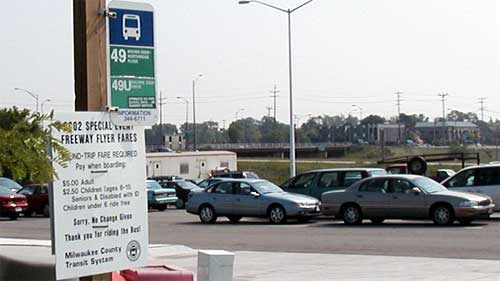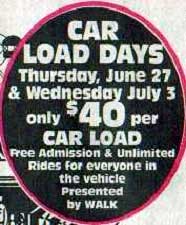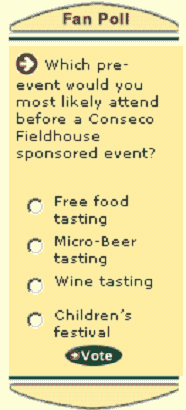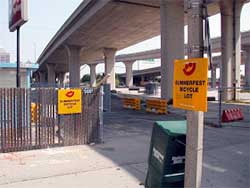
Managing Travel for Planned Special Events
Chapter Seven. Travel Demand Management and Traveler Information
Page 1 of 2

Figure 7-1. Planned Special Event Express Bus Service from Park and Ride Lot
Purpose 
This third chapter on event operations planning reviews strategies for: (1) mitigating the travel demand impacts of planned special events and (2) ensuring the transportation system operates as efficiently as possible on the day-of-event. Successful strategies are presented in three sections that influence travel choice utility; travel demand management, transit service, and pre-trip traveler information. These initiatives enhance transportation system operations and improve customer service for all users by utilizing all available system resources and excess capacity. The identification and successful promotion of travel demand management initiatives can reduce traffic demand and, in turn, improve system efficiency and travel time reliability.
Introduction 
Travel Demand Management (TDM) represents a key component of the overall advance planning process when forecasted traffic demand levels approach or exceed available road capacity. TDM strategies may be warranted for planned special events occurring during peak travel times, continuous events located in downtown areas, street use events of long duration, regional/multi-venue events, and special events in rural areas having limited transportation system capacity. The goal is to optimize event patron and non-attendee travel through incentives aimed at consolidating person trips and altering user travel patterns and habits, while minimizing any penalties to the user.
Transit service for a particular planned special event includes: (1) public transit service expansion or modification, (2) express buses from area neighborhoods or park and ride lots, and (3) charter bus service from other cities and counties. These services, though configured to net operators a profit, represent a travel demand management initiative. The goal of transit operators involve designing a special event service and related incentives to not only improve the travel choice utility associated with using transit, but also to exceed the utility (e.g., travel time, parking fees, comfort, etc.) associated with traveling via personal automobile. Successful transit services collectively may result in a significant change in event patron modal split without impacting service to non-attendee users.
The availability of pre-trip travel information, consisting of essential event operations and real-time traffic information, proves effective in assisting event patron evaluation of potential travel options, trip departure times, and travel routes to the event venue. Similarly, other road users, seeking to minimize event-related impacts to their trip, value this information.
TDM, transit, and pre-trip traveler information initiatives complement one another and work to reduce traffic on the roadway network in the vicinity of the event. These initiatives are not infrastructure improvements to increase capacity, but rather are methods that decrease vehicular traffic by providing event patrons with various travel choices as well as providing information that may lead to a reduction in traffic volumes. Some of these strategies are implemented by: (1) the public agency involved with the special event, (2) the event planners themselves, and (3) a combination of both groups.
Travel Demand Management 
Overview
TDM strategies are used to maximize the efficiency of the transportation system, thus reducing the volume of traffic on the roadway and minimizing the peak demand rates that cause congestion. They do not represent infrastructure improvements to increase capacity, but rather are methods that cause traffic demand reduction by encouraging other travel mode choices, particularly for event patrons. As shown in Table 7-1, TDM techniques for planned special events involve two distinct groups.
| User Group | Trip Purpose | TDM Goal |
|---|---|---|
| Event patrons | Traveling to the event itself |
|
| Non-attendee road users | Traveling for reasons other than the event itself |
|
Demand Management Strategies
Successful TDM strategies, developed to reduce the amount of event patron traffic, encourage the use of alternate travel modes. Essentially, a successful, integrated plan includes, for example, providing convenient alternates to driving an automobile to the event site and encouraging the use of these alternate travel modes. This includes increases in scheduled public transit service. In addition, express bus service can also be provided from park and ride lots to the event site as well as charter buses traveling to the event site from outlying areas. TDM strategies are also used to influence the travel patterns of non-attendee road users by encouraging a trip time shift or a change in travel mode. The resulting reduction in traffic demand reduces travel times for both event patrons and non-attendee road users. TDM also reduces delay, increases levels of safety, decreases motorist stress levels, reduces fuel consumption, and decreases certain vehicle emissions.
Table 7-2 contains a summary of travel demand management strategies.
| Strategy | Description | Techniques | User Group |
|---|---|---|---|
| High occupancy vehicle (HOV) incentives |
|
|
|
| Event patron incentives |
|
|
|
| Bicyclist accommodation |
|
|
|
| Local travel demand management |
|
|
|
High Occupancy Vehicle Incentives

Figure 7-2. High Occupancy Vehicle Incentive D
The ultimate goal of any high occupancy vehicle (HOV) strategy is to increase the number of persons traveling in each vehicle. One option to reduce the amount of vehicles on the roadway is to encourage HOV use. In some areas, limited-access highways include HOV lanes to increase the attractiveness and efficiency of carpooling and vanpooling. Many of these HOV lanes are intended to assist commuters on a daily basis and, as such, the hours of the HOV may be limited to weekday commuting hours. In the case of a major planned special event, consideration should be given to continuing the HOV restrictions on these lanes to later weekday hours, or even into weekend hours, in order to encourage event patrons to carpool.
Incentives can be provided to encourage two or more persons per vehicle. Figure 7-2 illustrates one such example. The Suffolk County Fair and a radio station (WALK) in New York offered a promotion of $40 per carload on certain days. This price included parking, fair admission, and unlimited rides for everyone in the vehicle. In this manner, it was not economically feasible to travel alone, but rather to travel with as many people as possible in one vehicle.
Another strategy to encourage HOV's involves offering special privileges at the event site. Special parking lots can be restricted to HOV only, and these lots may be located nearer to the venue in order to encourage carpools. Lower parking rates further increase the attractiveness of this initiative. Private parking lot operators can be persuaded to offer special HOV pricing in exchange for promotion in special event advertisements. As demonstrated by Figure 7-3, this information needs to be relayed to the public so that they know the advantages of carpooling to the event site.

Figure 7-3. High Occupancy Vehicle Parking Incentive (Graphic courtesy of the Seattle Center.) D
One successful implementation of HOV incentives took place at Husky Stadium on the campus of the University of Washington in Seattle for football games.(1) The Transportation Management Plan (TMP) included a parking pricing system to provide financial incentives for carpooling. During the 2000 football season, parking on campus cost $7 for vehicles with three or more persons and $10 for vehicles with less than three persons. Operators charged $17 for parking a recreational vehicle and $20 for buses, regardless of the number of people in the vehicle. In addition to the cost incentives, a marketing plan was also developed to encourage carpooling. Messages such as "carpools save time and money and are a lot more fun than going alone" were incorporated into the Husky football transportation guide.
In addition to the plan implemented for University of Washington football games, a similar plan was implemented for Seattle Seahawks football games during the 2000–2001 season when stadium construction forced the Seahawks to use Husky Stadium for home games. The public information campaign for Seahawks football included a summary of available parking in the vicinity of the stadium. Since the Seahawks were playing in a temporary stadium, fans had to be oriented to: (1) new traffic flow routes to access the stadium and (2) new event parking locations and costs. A public information campaign outlined Husky Stadium parking limitations, including only 9,000 on-campus spaces being provided as compared to the 11,000 free on-street parking spaces and 35,000 off-street parking spaces around the Seahawks original stadium. Carpool parking pricing incentives were established similar to those used for University of Washington football games. At the beginning of the season, game day parking was $15 for carpools with three or more persons per vehicle and $20 for vehicles with less than three persons. Stakeholders reduced the carpool parking fee in mid-season to $10 in an effort to increase higher vehicle occupancy.
In addition to venue operators offering HOV privileges at venue parking areas, private parking operators in the site area can also be encouraged to offer special incentives to event patrons. For example, if private lot operators offer a special HOV discount, then the event advertisements can mention that particular private lot by name and location. The "free advertising" may help private operators balance discounts given for HOV parking.
Thus, three high occupancy vehicle incentive techniques include:
- Consider continuing HOV restrictions on HOV lanes to later weekday hours, or even into weekend hours, in order to encourage event patrons to carpool.
- Reduce parking fees for vehicles with more than two people.
- Provide free advertising for private lots to balance discounts given for HOV parking.
Event Patron Incentives
Stakeholders managing discrete/recurring events at a permanent venue that generate high peak arrival and departure rates can encourage event patrons to arrive early or leave late in order to reduce the peak traffic demand.
Sporting events and concerts fall into this category given that, when the game or show ends, the majority of event patrons leave the venue at one time. This departure pattern scenario can be offset using several strategies:
- For instance, event organizers or venue operators can offer special incentives for spectators to stay after the event, such as special programming on the stadium video screens or post-event fireworks.
- Restaurants and pubs located in or near the event venue can remain open and may even offer special price savings with a ticket stub.
- Some sporting events and other types of events may feature live music after games in order to encourage spectators to remain at the venue.
- One incentive for parents to remain longer at sporting events with their children is a "meet the mascot" type of promotion.
- Venues in downtown areas can also provide extended parking, at no additional cost, for event patrons who wish to remain in the area and go to downtown restaurants or shops. Instead of parking lots having to be vacated a certain time after the event, extended parking hours allow event patrons to linger in the surrounding downtown area. These incentives help to spread out the flow of departing traffic and lessen the peak traffic demand on the roadway network. This concept also benefits businesses in the vicinity of the event venue.
Incentives that can be used to attract patrons to events earlier than usual include:
- Registration in free drawings and contests that occur before the event to attract spectators to the event site.
- Venue restaurants can open early and offer special incentives to attract spectators before the event.
- Tailgating may also be encouraged to attract event patrons to venue parking areas hours before the actual start of the event.
- Organizers of sporting events can encourage spectators to arrive early and watch teams warm-up before the game.

Figure 7-4. Venue Website Survey on Event Patron Incentives (Graphic courtesy of Conseco Fieldhouse.) D
Venues that do not have pre- or post-event activities can solicit suggestions from the public through mailings or via the venue website. For example, when season ticket applications or tickets to the event are mailed, an accompanying survey can ask event patrons which type of pre- or post-game activities they would be more likely to take advantage of. Similar types of questions can also be presented on an event or venue website, as illustrated in Figure 7-4. As a result, the pre- or post-game events will cater to the persons who actually attend the event, thus increasing the number of spectators attending staged activities. For recurring events, stakeholders can survey the patrons in the venue or distribute suggestion cards when patrons enter or exit the venue.
One example of implementing successful event patron incentives involves the San Jose, CA "America Festival". The website for this event alerted spectators that they need to plan ahead for the event's hallmark 4th of July fireworks display since the park venue reached capacity early the year before. The website suggested that event patrons arrive early and see one of the many bands that performed at the festival in addition to sampling the food and drinks available. In this manner, the arrival patterns to the event become spread out over a longer time period. Instead of all spectators showing up at one time, the arrival patterns are influenced by the music that the event patron would like to listen to. In addition, the availability of food and drinks at the festival also helps to spread out the arrival patterns. These incentives reduce congestion by reducing the peak arrival rate of event patrons. Collectively, the incentives convert a discrete event (fireworks display) into a continuous event (festival).
In addition to the recommendations for arriving event patrons, the website also suggested that spectators remain after the fireworks for another concert. Figure 7-5 displays the slogan posted on the event website. In this manner, stakeholders assumed that some event patrons would leave immediately after the fireworks display and some would stay to listen to the music. This reduces the peak departure demand on the transportation system. The post-fireworks concert entertained spectators as they waited for traffic congestion to dissipate. In turn, event patrons did not feel that they were just "sitting around and waiting" for congestion to dissipate.

Figure 7-5. Event Patron Incentive (Graphic courtesy of EHC & FILCO.) D
Bicyclist Accommodation
Another alternate form of transportation that can be used to access the event is a bicycle, especially in downtown areas. Special accommodations need to be provided for event patrons that wish to arrive by bicycle. Safety is a concern for all bicyclists, and proper bicycle paths need to be provided. These paths can consist of existing bike lanes and trails that are augmented with temporary paths leading to the event site. The provision of bicycle paths maximizes safety for the bicyclists and keeps them off roadways that experience higher traffic volumes due to the event.
Security represents a major concern of bicyclists. Figure 7-6 shows a bicycle parking area for a planned special event. In order to encourage bicycle travel, bicycle parking areas may be staffed (e.g., valet service) to prevent bicycle theft. In addition, if the bicycle parking area is located close to the entrance of the venue, it may encourage event patrons to use their bicycles in order to access the event easier. Public transit operators may also provide accommodations for bicycles during events, such as bicycle racks on the front of transit buses that allow spectators to access mass transit while carrying a bicycle.

Figure 7-6. Bicycle Parking Area
Local Travel Demand Management
TDM strategies that reduce the amount of background, non-attendee traffic consist of:
- Increasing the use of transit (e.g. transit promotion).
- Encouraging use of carpools.
- Shifting of work hours.
- Shifting of commercial truck travel routes and delivery/travel times.
For non-attendee road users, a successful TDM plan encourages alternate travel choices, such as avoiding travel during times of event ingress/egress or travel near the event venue, that ultimately increase mobility and travel time reliability for these users compared to their default travel choice. This includes personal and business travel in addition to commercial truck travel.
Businesses can help minimize traffic demand during peak commuting hours through implementing TDM strategies such as:
- Telecommuting
- Flexible hours
- Modified delivery schedules
Carpooling should also be encouraged by major employers and through public information campaigns. In order to assist the business community in the implementation of TDM, information detailing recommended strategies and how to implement them should be distributed.
The event planning team should inform the local community as to the magnitude of the planned special event through a series of press releases and public service announcements. Alternate routes to and around the event can also be published in daily newspapers, discussed on local television or radio news, and communicated by public and private traveler information services.
In the special case of events that occur infrequently, businesses located in the immediate vicinity of a venue (e.g., hosting a Monday Night Football game) may allow employees to leave early on event dates. This initiative causes an increase in parking supply for event patrons. A public information campaign can be used to notify businesses of the possible problems that could occur and how these problems can be alleviated by clearing, for example, a downtown area prior to a certain time.
Successful local travel demand management techniques, instituted by local businesses, were utilized during the 2002 Winter Olympics in Salt Lake City, Utah.(2) These strategies effected a change in residents' travel patterns during the event. A post-event telephone survey indicated that about one-fifth of residents changed their travel patterns during the games. The predominant change involved employers revising normal work schedules during the event and allowing earlier work hours or flexible schedules.
In order to reduce commercial truck traffic, stakeholders should contact pertinent trucking companies and advise them of times that truckers should avoid traversing freeway and arterial corridors serving the event venue. Trucking companies should attempt to reduce the number of truck trips made and shift some of their remaining truck trips to nighttime hours. Special mailings can be sent to long haul trucking companies in order to inform them of an upcoming planned special event and affected road corridors. In addition, fliers can be distributed to truck drivers at major points of entry to the region, disseminating information on the days and times of the event, high impact locations, and special traffic patterns. During the event, e-mails containing traffic advisories can be sent to trucking companies so that they can, in turn, get the word out to truckers via citizens-band radio and through their electronic distribution lists. Portable changeable message signs (CMS) and highway advisory radio (HAR) can also be placed at major ports of entry to alert truck drivers.(2)
Some components of a successful freight management plan include requiring trucks to have permits to enter certain areas between a set time frame. In this way only trucks that need to be in the area will be present during peak traffic times. In addition, delivery hours can be restricted to overnight to completely avoid conflict with event traffic. Long-haul trucking can be discouraged from certain roadways in the event area by providing directions on the roadway that divert trucks around the area surrounding an event venue.
Planned Special Events Traffic Management | Privacy Policy